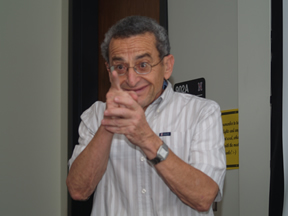
Anatoly Gitelson thought that he had been summoned to a meeting in mid-July with Prem Paul, Don Wilhite and others to discuss matters of strategic importance. Instead, the professor of remote sensing at UNL’s School of Natural Resources found a room full of long-time colleagues, students and friends, gathered to celebrate his lifetime of accomplishment, the start of a new project, and a birthday ending in “0.”
There Gitelson learned that the forthcoming edition of the Israel Journal of Plant Sciences is dedicated to him, including a tribute, “A Physicist in the Plant Kingdom,” and a list of his publications from 1990 through 2011. He received a plaque showing the cover of the commemorative journal and the inscription, “Friends and colleagues from around the world honor Anatoly Gitelson.”
In one of the articles in the special edition, one of his former students, Art Zygielbaum, now an adjunct associate professor at SNR, and co-authors Tim Arkebauer, Elizabeth Walter-Shea, and Dave Scoby wrote, “Anatoly Gitelson has been a key participant in the research reported here. His considerable insight, knowledge, enthusiasm, humor and encouragement helped guide our work and challenged us to perform rigorous analyses of our data. As a colleague, teacher, mentor, and friend, Anatoly is a vital part of our academic lives and careers. We are proud . . . to acknowledge Anatoly, his contributions to science, and his dedication to his research, students, and colleagues.”
Gitelson, who specializes in using satellite data to assess plant conditions, will relocate to the Israel Institute of Technology in Haifa in late August to continue his work for UNL. He will establish a global crop modeling consortium, and will be able to work closely with colleagues in Europe and other countries who have valuable data to share.
Gitelson has led development of a crop model at UNL that estimates yield, crop status and conditions, and needs to work with colleagues around the world to compare their data on actual crop yields to the model’s predictions. “I’ll be working with friends in Europe – where they have lots of data from Africa – and Japan and China,” he said. “They will all benefit if we are successful.”
The UNL model uses data from NASA’s MODIS satellite, and next year will begin using data from the European Sentinel-2 satellites.
“In principle, we know it will work,” he said. “But do we need to change coefficients to model wheat in Argentina, or soybeans in Brazil, or rice in Japan and China?”
Gitelson, who is originally from Russia, immigrated to Israel in 1990, and chose to come to UNL in 2000 – over other, more prestigious institutions -- to work with Don Rundquist at UNL’s Center for Advanced Land Management Information Technologies (CALMIT), which is now based in the School of Natural Resources.
“Don Rundquist created a great infrastructure within CALMIT,” Gitelson said, and added that colleagues such as Shashi Verma, who led the Great Plains Regional Center for Global Environmental Change, and others in agronomy, contributed invaluable data to the project. “It’s not just crop yield, but also leaf area, biomass, and all the biophysical characteristics of crops, plus gross primary production,” Gitelson said. “What we’ve got at UNL is really incomparable.”
Gitelson has a master’s and Ph.D. from the Institute of Radio Technology in Taganrog in the former Soviet Union. In Israel, he was a scientist, professor and department head at the J. Blaustein Institute for Desert Research, Ben-Gurion University of the Negev. At UNL, in addition to pursuing a vigorous research agenda, Gitelson taught classes and has worked with eight Ph.D. students, including two still in progress. He has published more than 150 peer-reviewed papers.
-- Kelly Helm Smith, School of Natural Resources